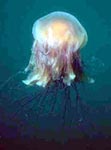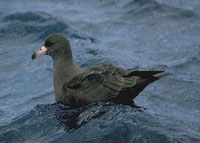Deepseawaters Calendar
By Month - Jan | Feb | March |april | May | June | Aug | Sep | Oct | Nov | Dec
Deepseawaters Calendar - October
The rising of the palolo, a marine worm that ejects its motile gametophores, occurs approximately one week after the full October moon in Fagatele Bay National Marine Sanctuary, American Samoa. Considered a delicacy, the palolo worm's egg and sperm packets are cooked and eaten.
Peak humpback and blue whale sightings, relaxation period at Cordell Bank begins. This becomes the best time of year to visit Cordell Bank National Marine Sanctuary.

The season's last nests of loggerhead sea turtle hatchlings make their way down Georgia's beaches to begin the journey of their lives. They swim out to the Gulf Stream where they will spend the next several years traveling in the North Atlantic Gyre. When they reach the size of dinner plates, they jump off that great watery merry-go-round and head inshore using Gray's Reef for food and rest throughout the rest of their lives.
The humpback whale population starts to thin out in the Stellwagen Bank National Marine Sanctuary in Massachusetts as individual whales begin their southward migration to the calving and breeding grounds in the Caribbean. Northern right whales make sporadic appearances in the sanctuary and Cape Cod Bay to feed on accumulations of zooplankton.
Pods of thousands of Pacific white-sided dolphins likely to be seen cruising the Cordell Bank Sanctuary waters through the fall and winter.
Warm weather, calm winds and seas are common in the early fall months in the Channel Islands National Marine Sanctuary. This is the best time of year for snorkeling, kayaking, and diving. Underwater visibility can reach 100 feet.

Jellies of all kinds are abundant in California coastal waters as the oceanic season begins and upwelling winds start to relax (August through November).

Pink-Footed Shearwaters (Puffinus creatopus) and Sooty Shearwaters (Puffinus griseus) visit the Santa Barbara Channel from the southern hemisphere (May through October).
Ashy Storm-Petrels (Oceanodroma homochroa) and Black Storm-Petrels (Oceanodroma melania) visit the Santa Barbara Channel (mid-May to mid-October).
Red-Necked Phalaropes (Phalaropus lobatus) can be seen in the Santa Barbara Channel in the spring (April and May) and fall (August through October).
 Deep Sea Crabs
Deep Sea Crabs